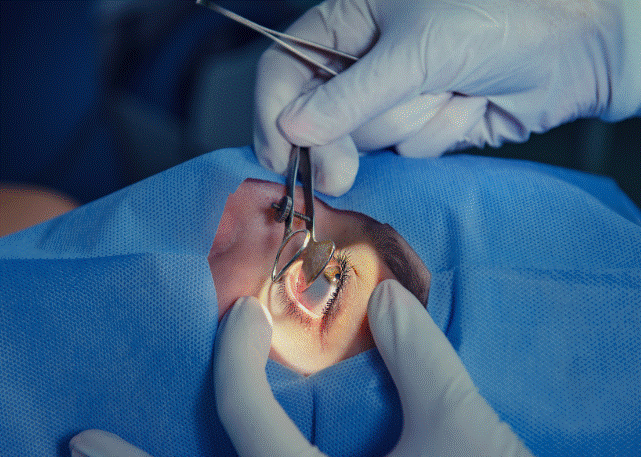Cataract Surgery
A cataract is a condition known as clouding the eye’s normally clear lens that can eventually obstruct vision.
Cataracts become more common as people get older. According to the National Eye Institute, by age 80, more than half of Americans will either have a cataract or have had one surgically removed.
Cataracts do not have to be treated unless they interfere with vision. They often grow slowly and can take years before they cause a problem.
Swapping your eyeglass or contact lens prescription may be enough to treat minor vision loss from cataracts temporarily.
If a cataract cloud your vision to the extent that activities such as driving become difficult, the only way to effectively treat it is with surgery.
During cataract surgery, the clouded lens is removed and replaced with a clear plastic artificial lens called an intraocular lens (IOL).
Cataract surgical procedure is among the most frequently performed procedures globally, and it is considered very safe and effective.
BEFORE SURGERY
An eye doctor called an ophthalmologist might recommend cataract surgery if a cataract is interfering with your vision and making it difficult for you to do everyday tasks like driving or reading.
The doctor will evaluate you before surgery to make sure you are a good candidate for the procedure.
Having another eye condition such as glaucoma or macular degeneration can make cataract surgery less successful and riskier.
Before cataract surgery, the doctor will measure your eye to fit you for the correct IOL. A few different types of lenses are available.
Most are flexible, but some are rigid.
Your doctor will recommend one of these lens types based on your vision needs:
- Fixed-focus lenses help you see at only one distance, near or far.
- Accommodating lenses shift focus from near to medium to far, much as a natural lens would.
- Multifocal lenses have different powers built into them, similar to bifocal eyeglasses. With them, you can see close up, at a distance, and in between.
- Toric lenses correct for astigmatism—blurred vision caused by an irregularly shaped cornea.
Your doctor can tell you to stop using certain medications for a week or so before the procedure because they could increase your risk for bleeding during surgery.
You may also need to use antibiotic eye drops a day or two before the procedure to prevent an infection.
WHAT TO EXPECT
Cataract surgery is usually done as an outpatient treatment at a hospital or surgery center. Your doctor might advise you not to eat or drink for six hours before the surgery.
This surgery is generally performed on only one eye at a time. The doctor will first numb your eye with drops and possibly an injection.
You might also receive a sedative to assist you in relaxing during the procedure. You will be awake, but you will not feel any pain or see the surgery.
Cataract surgery can be performed in one of two ways. Small incision surgery is done through a small opening in the cornea—the eye’s clear outer covering.
The doctor will use a probe that emits ultrasound waves to break the clouded lens into small pieces. This procedure is called phacoemulsification.
Then suction is used to remove the pieces of the lens through the incision.
Less often, doctors remove the whole lens intact through a larger incision. This procedure, called extracapsular surgery, may be done if cataracts have made the lens so hard that the doctor cannot break it up.
Either way, the surgery is performed, the doctor will leave the outer membrane of the lens, called the lens capsule, in place.
After the old lens has been removed, the doctor will put the new, clear IOL onto the capsule. The whole operation should last less than one hour. You will be able to go home afterward.
Most small-incision cataract surgery uses self-sealing incisions that do not require stitches. A larger incision may require a stitch or two to close.
A shield or patch will be placed over the affected eye to protect it for a few days, especially while you sleep.
AFTER SURGERY
Your eyes might be blurry for a few days after surgery, but your vision should eventually clear.
You will have to use eye drops to prevent infection and inflammation and control your eye pressure.
You will need to avoid driving, bending, and lifting anything heavy until your doctor tells you that these activities are safe to restart.
Do not rub or scratch your eye while it heals. You will have regular follow-up visits with your doctor for up to six months post your surgery to assure that you are healing properly.
It can take up to eight weeks to fully heal from cataract surgery. Your doctor will tell you to know when you can resume exercise and other activities.
If you need surgery performed on the other eye, it can be done after the first eye has fully healed.
Most people have good results from cataract surgery. If you have a fixed-focused lens implanted, you may still need to wear glasses during activities such as reading or driving.
RISKS
Cataract surgery is considered safe, but like any surgical procedure, it can have risks.
The most common problems associated with this procedure are:
- infection
- pain that does not improve
- bleeding in the eye
- swelling inside the eye or of the retina—the layer of tissue in the back of the eye
- drooping eyelid
- the buildup of fluid in the retina
- movement of the artificial lens out of place
- detached retina
- injury to another part of the eye
- increased pressure in the eye, leading to glaucoma
- another cataract
- vision loss
Up to half of the cataract surgery, people later develop a secondary cataract or posterior capsule opacification (PCO).
Cells grow over the lens capsule that holds the new lens in place, causing the capsule to cloud over and produce blurry vision.
A simple laser procedure can relieve the cloudiness by creating a small opening in the capsule to let in light.
This procedure requires less than five minutes and most people have clearer vision afterward.
Resources
Websites
Boyd, Kierstan “Cataract surgery.” American Academy of Ophtalmology. November 9, 2018. https://www.aao.org/eye-health/diseases/what-is-cataract-surgery (accessed November 29, 2018).
“Cataract surgery.” American Optometric Association https://www.aoa.org/patients-and-public/eye-and-vision-problems/glossary-of-eye-and-vision-conditions/cataract/cataract-surgery (accessed November 29, 2018).
“Cataract surgery.” Mayo Clinic. March 22, 2018. https://www.mayoclinic.org/tests-procedures/cataract-surgery/about/pac-20384765 (accessed November 29, 2018).
Organizations
American Academy of Ophthalmology, 655 Beach Street, San Francisco, CA, 94109, (415) 561-8500, https://www.aao.org .
American Optometric Association, 243 N. Lindbergh Blvd., St. Louis, MO, 63141-7881, (800) 365-2219, https://www.aoa.org .
National Eye Institute, 31 Center Drive MSC 2510, Bethesda, MD, 20892-2510, (301) 496-5248, [email protected], https://www.nei.nih.gov .








